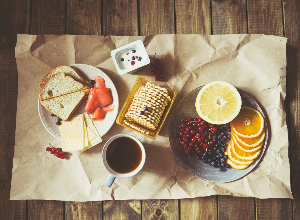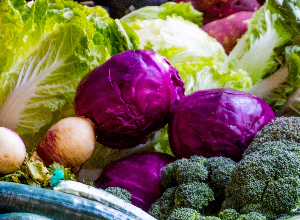Diabetes: Nutrition Tips, Part 1
Published Jan 10, 2019
An interview with Elisa Cloteau, dietitian and nutritionist.

Could you please tell us about yourself in a few words Elisa?
I am a dietitian-nutritionist and I offer advice on nutrition for individuals and companies, for example, coaching for weight loss, diabetes prevention, specific services for women (puberty, pregnancy, menopause, osteoporosis prevention) and athletes, workshops on chocology, health prevention, etc. Since 2016, I am approved by the League contre le cancer (“Ligue against cancer”, a French-based association created in 1918 to support cancer patients and finance medical research in cancer).
Can you please tell us what a diabetic patient should pay attention to in terms of nutrition?
There are several things that one needs to keep in mind: the quantity of starches compared to the quantity of vegetables, the quantity of starches in regard to the level of sedentariness, the quantity of sugar, sweets, sweetened drinks, the quantity of fat, etc. It is also important to limit the intake of swelled cereal.
How to lower your blood glucose level?
To lower your blood glucose level, it is important to consume more vegetables than starches in the same meal. It is recommended to choose vegetables rich in fibres. Why? The presence of fibres in your food slows down the absorption of carbs (carbohydrates) and reduces the need for insulin.
Other important issues:
- Consume legumes and whole grain cereal several times a week, but don’t fall into the trap of eating only whole grain products.
- Avoid sweet snacks between the meals
- Regularly practice 12 hour carbohydrates abstinence
- Do some sport or walk several times a week (a minimum of 5000 steps per day – use a pedometer to count the steps).
What kind of food patients with diabetes should avoid?
Nothing is forbidden, but you need to manage certain deviations. The following products are not recommended for daily consumption: all forms of fast sugars like glucose-fructose syrup, sucrose, sodas, candies, alcohol.
It is important to monitor the consumption of fats, in order to protect your capillary and circulatory system, and not to consume too many saturated fats:
- Control the consumption of animal fat: butter, cheese, delicatessen, fat meat
- Eliminate hydrogenated, partially hydrogenated and processed fats
Can you eat fruit if you are dealing with diabetes?
Fruit is part of a well-balanced diet. Certain fruits contain more sugar than others, but we are allowed to eat all of them. However, every consumption must represent a portion. You shouldn’t eat several portions at one meal, because fruit consumption is not unlimited: you can have 1 or 2 portions per day. It is necessary to learn to evaluate a portion.
Dried fruit is recommended, but canned fruit in syrup is too rich in sugar.
Fruit juice must be consumed with caution and must be labelled “with no added sugar”. However, some juices like apple or grape juice for example, naturally contain large quantities of sugar. Fruit sugar from juices enters the blood faster than sugar from a fruit which contains fibre, slowing down the sugar transit.
Keep in mind that fruit juice, fruit nectar and fruit drink all have different amounts of sugar.
Compotes: choose the ones with no added sugar, and make sure they don’t contain concentrate juice.
If glycemia is difficult to manage, avoid eating fruit between the the meals.
What can you eat for breakfast when you suffer with diabetes?
Muesli with no added sugar, oatmeal with milk or plain yoghurt, and possibly one seasonal fruit and a handful of oleaginous fruits. You can also add fibre – 1 or 2 teaspoons of oat bran.
Or:
- Bread (not white) with butter or cheese
- Some proteins: an egg or ham or cold meat
- A seasonal fruit and a handful of oleaginous fruits.
Breakfast is essential for your health and must be well-balanced. Otherwise your blood sugar levels can be destabilised. Depending on the amount of carbs you are allowed for each meal, you may be able to eat a fruit.
What beverages should (and shouldn’t) a person with diabetes drink?
You should prefer still water or water with gas (avoiding to drink mineral waters that often contain salt), tea, weak coffee, herbal teas and drinks, detox water and vegetable juices.
You shouldn’t trust flavored water and bottled tea, both containing too much sugar.
Drinks to avoid are: lemonade, soda (even “light”), drinks “containing fruit juice”, fruit nectar, drinkable fruit yoghurts, concentrated milk, smoothies, alcohol or alcohol-free cocktails, alcohol in general (it is rich in calories and increases your blood glucose level) – even wine, beer and cider. You can occasionally enjoy a glass of wine (but not sweet) during the meal. Avoid drinking alcohol between meals.
Are there any spices or other nutrients that reduce blood glucose level?
Foods rich in fibre can reduce blood sugar level. Various in-vitro and animal studies have confirmed the benefits of cinnamon in the regulation of glucose metabolism. In fact, cinnamon extract’s ingestion allows to potentiate the effect of insulin on insulin-sensible tissues.
Numerous studies have evaluated the effects of cinnamon on glucose metabolism in patients with type 2 diabetes. Khan’s study, for instance, focused on 60 patients with types 2 diabetes, receiving 1, 3 or 6 grams of cinnamon after the meal. Forty days later, fasting blood glucose level reduced by 18-29% in patients having received the supplement, compared to another group which didn’t. In another study, 79 diabetic patients received 3 grams of cinnamon, which resulted in fasting blood glucose level lowering by 10,3%.
Thanks a lot for this useful information! See you soon for the second interview on sugar and sugar substitutes.
Members, please feel free to comment, ask questions, and thank this member for the testimonial.
9 comments
You will also like

Fighting Schizophrenia Symptoms: a Long Journey Against Paranoia after Denial and being Admitted
Dec 12, 2018 • 6 comments

Diabetes: Discrimination, Professional Life, Plan Ahead... What do patients say?
Nov 9, 2018 • 9 comments

 Facebook
Facebook Twitter
Twitter





